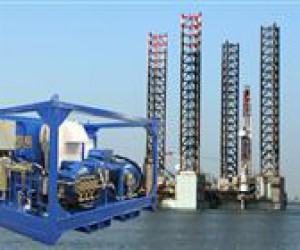Working safely and efficiently in the oil and gas industry not only requires expertise, but also equipment which is designed to perform in the demanding and highly regulated sector. The shear nature of the working environment means that both the personnel and the equipment must be suitably protected so as to minimise any risks as far as possible.
Mike Sherman, Marketing Manager for RMI Pressure Systems, a leading manufacturer of high-pressure pumping systems specifically for operation in this field, looks at the requirements for success.
A range of factors, including the higher cost of energy, the greater focus on safety and environmental concerns, as well as the increasing viability of new energy sources have combined to create a new set of competitive pressures on designers and engineers who develop oil and gas equipment and systems. RMI has applied its engineering expertise to develop new systems which deliver improved performance and efficiency.
Companies in the oil and gas industry simply do not have the time to conduct extensive, costly and time-consuming prototyping and testing regimens to validate design performance. What is required is a proven design that can deliver to the high level specifications while maintaining reliability and safety standards, leading to a reputation that can take years to earn.
In an evolving energy market, it is important that a company has the ability to respond to demands quickly and effectively and this is dependent on how well it can manage its internal design data and expertise. Oil and gas companies face competitive time pressures and require more modular design, and systems prefabrication. To meet this requirement, suppliers to the industry must be able to offer flexible solutions which effectively and reliably deliver results.
For RMI, its precise engineering skill combined with expertise in the oil and gas industry, allows it to deliver high pressure pumping solutions for a variety of applications including umbilical testing / flushing, hydrostatic pipe testing and blow-out prevention. All of these deliver process critical solutions to an industry that demands reliable and efficient performance.
In the case of hydraulic umbilicals, due to the critical nature of the systems and valves controlled by them, it is essential that the hydraulic lines be cleaned to the required specifications. The lines and connections must be completely free from leakage for proper system operation and reliability. In order to perform these tests and cleaning functions a test rig is required, ideally located on board the pumping platform and this requires the rig to be intrinsically safe to ensure crew safety.
The high pressure pumping system is capable of producing pressures up to 15,000 psi (1,035 bar) with flows between 3 - 15 US gallons/ min. (11 - 56 litres/min). Achieving these figures reduces the overall time required to fill, flush and pressure test the umbilical system, which in turn reduces the cost of the installation. In addition to these standard requirements, the entire rig must be intrinsically safe, meeting Class I, Div II classification for offshore use.
While umbilical systems provide the crucial connections between the subsea structures, there can be few more important structures than the blow-out prevention (BOP) system which provides a series of crisis prevention measures in the event of a potentially devastating scenario. The hydraulic power provided to these critical structures must come from the most reliable pumping system which has a proven record in the most demanding environments.
As the known reserves of oil and gas diminish, so companies involved in the industry continue to search for and exploit potential new sites. However, this is an extremely expensive process, requiring huge levels of investment which must deliver more efficient methods and equipment to ensure a return on investment. With this financial commitment comes the requirement for more reliable and efficient equipment to ensure that the development of each site is as cost effective as possible.










